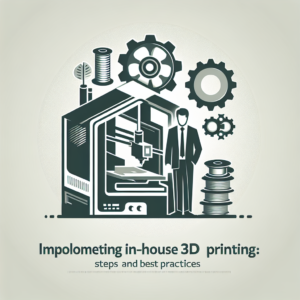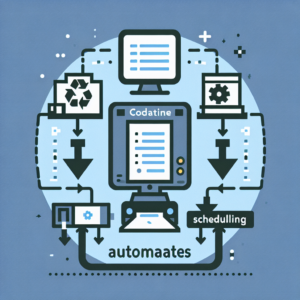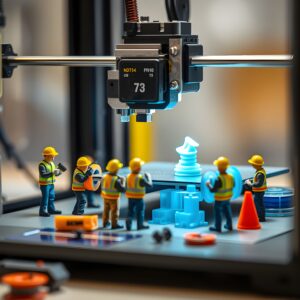Bring Products to Market Faster by 3D Printing Prototypes In-House

Revolutionizing Product Development with 3D Printing
In today’s competitive landscape, bringing products to market faster is a decisive factor for success. Traditional prototyping methods often involve high costs and extended lead times, which can delay product launches. However, in-house 3D printing of prototypes offers a game-changing solution, enabling companies to expedite product development cycles while cutting costs.
This article explores how businesses can leverage 3D printing technology to revolutionize their prototyping processes, highlighting current trends and innovations in 2024. From its advantages over traditional methods to actionable strategies for implementation, we delve into every aspect of using 3D printing for faster product development.
The Need for Speed: Challenges in Traditional Prototyping
High Costs and Lead Times
Traditional prototyping often requires outsourcing to specialized firms, resulting in significant costs and extended waiting periods. Each iteration involves redesign, manufacturing, and shipping, delaying the feedback loop necessary for improvements.
Lack of Flexibility
Traditional methods restrict the ability to test multiple variations simultaneously. This limitation hinders creativity and slows the innovation process.
Supply Chain Vulnerabilities
Global supply chain disruptions, a recurring issue in recent years, further exacerbate delays in traditional prototyping. Companies are left waiting weeks or even months for physical prototypes to arrive.
In-House 3D Printing: A Paradigm Shift
What is 3D Printing?
3D printing, or additive manufacturing, builds objects layer by layer using digital models. Technologies such as Fused Deposition Modeling (FDM), Stereolithography (SLA), and Selective Laser Sintering (SLS) are commonly used for prototyping.
Key Benefits of In-House 3D Printing
-
Faster Iterations: Design, print, test, and refine prototypes within hours or days rather than weeks.
-
Cost-Effectiveness: Eliminates outsourcing costs and reduces material waste.
-
Enhanced Confidentiality: Sensitive designs remain within the company, mitigating the risk of intellectual property theft.
-
Greater Design Freedom: Create complex geometries and customize prototypes with ease.
Implementing In-House 3D Printing: Steps and Best Practices
1. Assess Your Needs
Evaluate your product development process to identify areas where 3D printing can add value. Consider factors like prototype complexity, material requirements, and production volume.
2. Choose the Right 3D Printer
Selecting a suitable 3D printer depends on your application:
-
FDM: Ideal for basic prototypes using thermoplastics.
-
SLA: Perfect for detailed, high-resolution models.
-
SLS: Best for durable prototypes with complex geometries.
3. Integrate with CAD Software
Modern Computer-Aided Design (CAD) tools allow seamless integration with 3D printers. Programs like AutoCAD, SolidWorks, and Fusion 360 support quick adjustments and direct printing.
4. Train Your Team
Invest in training employees to operate 3D printers and utilize design software effectively. Skilled operators ensure optimal printer usage and minimize errors.
5. Optimize Material Usage
Use the right materials for your prototypes. Options include PLA for basic models, ABS for durable parts, and photopolymer resins for intricate details.
Real-World Applications and Success Stories
Case Study: Automotive Industry
An automotive startup reduced its prototyping time by 60% using in-house 3D printing. By iterating designs daily, the company introduced a new vehicle model six months ahead of schedule.
Case Study: Consumer Electronics
A leading electronics firm adopted SLA printing to create high-resolution prototypes of new gadgets. This approach allowed them to test ergonomics and functionality faster than competitors.
Innovations in 2024: What’s New in 3D Printing?
AI-Powered Design Optimization
AI-driven software now integrates with 3D printing workflows, enabling designers to create more efficient prototypes automatically.
Biodegradable Materials
Sustainability is a growing focus in 2024, with advancements in biodegradable and recyclable printing materials reducing environmental impact.
Cloud-Based Collaboration
Cloud platforms allow teams to collaborate remotely on prototype designs, streamlining communication and reducing downtime.
Common Challenges and How to Overcome Them
Printer Maintenance
Regular maintenance ensures consistent performance. Schedule routine checks and replace worn parts promptly.
Material Costs
Bulk purchasing and recycling programs can help reduce material expenses without compromising quality.
Learning Curve
Adopting new technology can be daunting. Start small with pilot projects and expand as your team gains confidence.
Program Coding Example: Automating Print Job Scheduling
import time
from printer_api import Printer
# Initialize printer
printer = Printer(model='FDM-2024')
# Define prototype queue
prototype_queue = [
{'name': 'Prototype_A', 'material': 'PLA', 'time_estimate': 4},
{'name': 'Prototype_B', 'material': 'ABS', 'time_estimate': 6},
]
# Automate print scheduling
for job in prototype_queue:
print(f"Starting print job: {job['name']}")
printer.load_material(job['material'])
printer.start_job(job['name'], job['time_estimate'])
time.sleep(job['time_estimate'] * 3600) # Simulate print time
print(f"Completed: {job['name']}")
print("All print jobs completed.")FAQ: Addressing Common Questions
1. How much does a 3D printer cost?
Prices range from $500 for basic models to $50,000 for industrial-grade printers.
2. What materials can be used for prototyping?
Materials include PLA, ABS, resin, and metal powders, depending on the printer type.
3. Is 3D printing environmentally friendly?
While traditional materials can be wasteful, newer biodegradable options and recycling programs make 3D printing more sustainable.
Embrace the Future of Prototyping
In-house 3D printing is no longer a luxury but a necessity for businesses aiming to stay ahead. By reducing lead times, lowering costs, and enhancing flexibility, this technology empowers companies to innovate faster and more efficiently. As advancements continue in 2024, integrating 3D printing into your workflow will prove to be a strategic advantage.
Visit our other website: https://synergypublish.com





